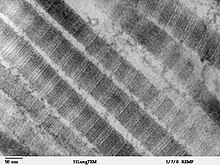Acrogeria
| Acrogeria | |
|---|---|
| Other names | Acrogeria, Gottron type, Gottron's syndrome[1] |
 | |
| Fibers of Collagen Type I - TEM | |
| Specialty | Dermatology |
Acrogeria (Gottron's syndrome) is a skin condition characterized by premature aging, typically in the form of unusually fragile, thin skin on the hands and feet (distal extremities).[1] The prefix "acro" stems from the Greek akros which alludes to "extremity, tip" while the suffix "geria" comes from the Greek gerôn which means "elder".[citation needed]
This is one of the classic
Onset is often in early childhood, it progresses over the next few years and then remains stable over time with morphology, colour and site remaining constant. A bruising tendency has been observed.[3] Mutations in the COL3A1 gene, located at chromosome 2q31–q32, have been reported in varied phenotypes, including acrogeria and vascular rupture in Ehlers-Danlos' syndrome (more especially type IV).[4]
See also
- Hutchinson–Gilford syndrome
- List of cutaneous conditions
References
- ^ ISBN 978-1-4160-2999-1.
- ^ a b Gottron, H. Familiaere Akrogerie. Arch. Derm. Syph. 181: 571-583, 1940.
- PMID 10694296.
- PMID 8881656.
